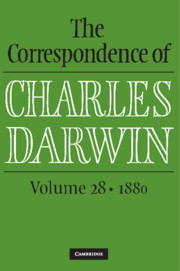Refine search
Actions for selected content:
10298 results in History of science: general interest
Notes on manuscript sources
-
- Book:
- The Correspondence of Charles Darwin
- Published online:
- 16 March 2021
- Print publication:
- 01 April 2021, pp 740-742
-
- Chapter
- Export citation
Contents
-
- Book:
- The Correspondence of Charles Darwin
- Published online:
- 16 March 2021
- Print publication:
- 01 April 2021, pp vii-vii
-
- Chapter
- Export citation
Frontispiece
-
- Book:
- The Correspondence of Charles Darwin
- Published online:
- 16 March 2021
- Print publication:
- 01 April 2021, pp i-iv
-
- Chapter
- Export citation
Biographical register and index to correspondents
-
- Book:
- The Correspondence of Charles Darwin
- Published online:
- 16 March 2021
- Print publication:
- 01 April 2021, pp 599-699
-
- Chapter
- Export citation
Introduction
-
- Book:
- The Correspondence of Charles Darwin
- Published online:
- 16 March 2021
- Print publication:
- 01 April 2021, pp xvii-xxvi
-
- Chapter
- Export citation
II - Chronology
-
- Book:
- The Correspondence of Charles Darwin
- Published online:
- 16 March 2021
- Print publication:
- 01 April 2021, pp 565-568
-
- Chapter
- Export citation
List of illustrations
-
- Book:
- The Correspondence of Charles Darwin
- Published online:
- 16 March 2021
- Print publication:
- 01 April 2021, pp viii-viii
-
- Chapter
- Export citation
III - Diplomas and testimonials
-
- Book:
- The Correspondence of Charles Darwin
- Published online:
- 16 March 2021
- Print publication:
- 01 April 2021, pp 569-573
-
- Chapter
- Export citation
Acknowledgements
-
- Book:
- The Correspondence of Charles Darwin
- Published online:
- 16 March 2021
- Print publication:
- 01 April 2021, pp xxvii-xxx
-
- Chapter
- Export citation
Note on editorial policy
-
- Book:
- The Correspondence of Charles Darwin
- Published online:
- 16 March 2021
- Print publication:
- 01 April 2021, pp xxxiv-xxxix
-
- Chapter
- Export citation
Darwin/Wedgwood genealogy
-
- Book:
- The Correspondence of Charles Darwin
- Published online:
- 16 March 2021
- Print publication:
- 01 April 2021, pp xl-xli
-
- Chapter
- Export citation
IV - Presentation list for Movement in plants
-
- Book:
- The Correspondence of Charles Darwin
- Published online:
- 16 March 2021
- Print publication:
- 01 April 2021, pp 574-577
-
- Chapter
- Export citation
List of letters
-
- Book:
- The Correspondence of Charles Darwin
- Published online:
- 16 March 2021
- Print publication:
- 01 April 2021, pp ix-xvi
-
- Chapter
- Export citation
Priorities in Medical Research: elite dynamics in a pivotal episode for British health research
-
- Journal:
- The British Journal for the History of Science / Volume 54 / Issue 2 / June 2021
- Published online by Cambridge University Press:
- 23 March 2021, pp. 195-211
- Print publication:
- June 2021
-
- Article
- Export citation
Managing the observatory: discipline, order and disorder at Greenwich, 1835–1933
-
- Journal:
- The British Journal for the History of Science / Volume 54 / Issue 2 / June 2021
- Published online by Cambridge University Press:
- 19 March 2021, pp. 155-175
- Print publication:
- June 2021
-
- Article
- Export citation

The Correspondence of Charles Darwin
-
- Published online:
- 16 March 2021
- Print publication:
- 01 April 2021
The Society of Astrologers (c.1647–1684): sermons, feasts and the resuscitation of astrology in seventeenth-century London
-
- Journal:
- The British Journal for the History of Science / Volume 54 / Issue 2 / June 2021
- Published online by Cambridge University Press:
- 15 March 2021, pp. 133-153
- Print publication:
- June 2021
-
- Article
- Export citation
Ido Hartogsohn, The American Trip: Set, Setting, and the Psychedelic Experience in the Twentieth Century Cambridge, MA: MIT Press, 2020. Pp. 432. ISBN: 978-0-2625-3914-2. $35.00 (paperback)
-
- Journal:
- The British Journal for the History of Science / Volume 54 / Issue 1 / March 2021
- Published online by Cambridge University Press:
- 11 May 2021, pp. 109-111
- Print publication:
- March 2021
-
- Article
- Export citation
Alexander Jones and Liba Taub (eds.), The Cambridge History of Science, vol. 1, Ancient Science Cambridge: Cambridge University Press, 2018. Pp. xix + 642. ISBN 978-0-511-98014-5. £120.00 (hardback)
-
- Journal:
- The British Journal for the History of Science / Volume 54 / Issue 1 / March 2021
- Published online by Cambridge University Press:
- 11 May 2021, pp. 124-125
- Print publication:
- March 2021
-
- Article
- Export citation
Audra Wolfe, Freedom's Laboratory: The Cold War Struggle for the Soul of Science Baltimore: Johns Hopkins University Press, 2018. Pp. x + 302. ISBN 978-1-4214-2673-0. $29.95 (hardback). ISBN 978-1-4214-3908-2. $19.95 (paperback)
-
- Journal:
- The British Journal for the History of Science / Volume 54 / Issue 1 / March 2021
- Published online by Cambridge University Press:
- 11 May 2021, pp. 120-122
- Print publication:
- March 2021
-
- Article
- Export citation
